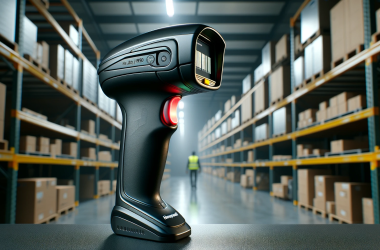Barcode scanners have become an essential tool in many industries, enabling businesses to efficiently track inventory, improve productivity, and enhance customer service. In this comprehensive guide, we will explore everything you need to know about barcode scanners, from their basic functionality to choosing the right one for your specific needs. We will also delve into best practices for using barcode scanners effectively and discuss the exciting future developments in this field.
Understanding Barcode Scanners
The Basics of Barcode Scanners
At their core, barcode scanners are handheld devices or fixed-mount scanners that capture and read barcode information. Barcodes are a series of parallel lines of varying widths that represent data, such as product numbers, prices, or other identifying information.
Barcode scanners use a light source, typically a laser or LED, to illuminate the barcode. Then, a photosensitive sensor detects the reflected light and converts it into an electrical signal. This signal is decoded to extract the encoded information.
But let’s dive deeper into the world of barcode scanners and explore the various types available, their unique features, and how they work.
Types of Barcode Scanners
There are several types of barcode scanners available, each with its own unique features and benefits. Let’s take a closer look at some of them:
- Laser barcode scanners: Laser scanners use a laser beam to read barcodes. They are highly accurate and can read barcodes from a distance, making them suitable for retail settings where speed and efficiency are crucial. With their ability to quickly scan barcodes, they help streamline the checkout process, reducing waiting times for customers.
- Imager barcode scanners: Imager scanners use a camera and image-processing software to capture and decode barcodes. They can read barcodes from various angles and even from smartphone screens, making them versatile for different applications. Imager scanners are commonly used in industries like healthcare, where they can quickly scan patient wristbands or medication labels.
- 2D barcode scanners: 2D scanners can read both traditional linear barcodes and 2D symbologies like QR codes. They offer enhanced data capacity, allowing businesses to store more information within a single barcode. This versatility makes them ideal for applications that require storing large amounts of data, such as inventory management or ticketing systems.
- Wireless barcode scanners: Wireless scanners provide the freedom to move around and scan barcodes without being tethered to a computer or POS system. They use Bluetooth technology to transmit scanned data to a receiver device. This flexibility is especially useful in environments where mobility is essential, such as warehouses or large retail stores.
How Barcode Scanners Work
Barcode scanners work by following a series of sequential steps to capture and decode barcode information:
- The scanner emits a beam of light onto the barcode. This light illuminates the barcode, making it easier to capture the necessary information.
- The barcode reflects the light back to the scanner. The reflective properties of the barcode lines allow the scanner to detect and capture the information encoded within.
- The scanner detects the reflected light and generates an electrical signal. This signal is a representation of the barcode’s pattern, which needs to be converted into readable data.
- The signal is processed and analyzed to extract the encoded data. The scanner’s internal circuitry decodes the electrical signal, converting it into a format that can be understood and interpreted.
- The decoded information is sent to the connected device, such as a computer or POS system, for further processing. This allows businesses to utilize the captured barcode data for inventory management, sales tracking, or any other relevant application.
Barcode scanners have become an integral part of various industries, revolutionizing the way businesses handle inventory, track sales, and improve overall efficiency. With their ability to quickly and accurately capture barcode information, they have become indispensable tools in today’s fast-paced world.
Choosing the Right Barcode Scanner
When it comes to running a successful business, efficiency is key. One way to streamline your operations is by investing in a barcode scanner. But with so many options available, how do you choose the right one? Let’s explore some factors to consider when buying a barcode scanner.
Factors to Consider When Buying
When selecting a barcode scanner for your business, it’s crucial to consider various factors:
- Application requirements: Determine the type of barcodes you need to scan and the environment in which the scanner will be used. Are you scanning barcodes on products in a retail store? Or are you scanning barcodes on packages in a warehouse? Understanding your specific requirements will help you choose a scanner that meets your needs.
- Ease of use: Look for scanners that offer intuitive controls and ergonomic designs to minimize user fatigue. A comfortable scanner can make a big difference in the productivity and satisfaction of your employees.
- Connectivity options: Consider whether you need a wired or wireless scanner, depending on your workflow and device compatibility. Wireless scanners offer more flexibility and mobility, allowing your employees to move around freely while scanning.
- Scan speed and accuracy: Evaluate the scanner’s scanning speed and error rate to ensure efficient and reliable performance. A fast and accurate scanner can significantly improve your operational efficiency.
Barcode Scanner Features
Barcode scanners come with various features that can enhance their functionality and efficiency:
- Auto-sensing capability: Some scanners automatically detect the presence of a barcode and start scanning without the need for a trigger. This feature can save time and improve productivity, especially in high-volume scanning environments.
- Data capturing abilities: Look for scanners that have the capability to capture not only barcode information but also images or signatures, depending on your application needs. This versatility can expand the range of tasks your scanner can handle.
- Integrated software solutions: Some scanners come with built-in software that enables advanced data processing and integration with existing systems. This can simplify your workflow and eliminate the need for additional software or hardware.
Price vs. Quality in Barcode Scanners
When it comes to barcode scanners, it’s important to strike the right balance between price and quality. While cost-effective options may seem attractive, they may not offer the durability and performance required for long-term use. Investing in a high-quality scanner may save you money in the long run by reducing downtime and maintenance costs.
Now that you have a better understanding of the factors to consider and the features available in barcode scanners, you can make an informed decision that will benefit your business. Choose wisely and enjoy the efficiency and productivity that a barcode scanner can bring to your operations.
Using Barcode Scanners Effectively
Best Practices for Scanning
To maximize the effectiveness of barcode scanners, consider the following best practices:
- Maintain clean barcodes: Ensure that barcodes are clear, clean, and undamaged to facilitate accurate scanning.
- Proper positioning: Hold the scanner steady and position it directly in front of the barcode to achieve optimal scanning results.
- Train employees: Provide comprehensive training to employees to ensure they understand how to use the scanner correctly and efficiently.
Troubleshooting Common Issues
Despite their reliability, barcode scanners may encounter certain issues. Here are some common problems and their potential solutions:
- Scanning failures: Check if the barcode is readable and properly aligned with the scanner. Clean the scanner lens if necessary.
- Connectivity problems: Ensure that the scanner is connected to the correct device and that the communication settings are properly configured.
- Low battery life: If using a wireless scanner, make sure the battery is fully charged or replace it if necessary.
Maintenance and Care for Barcode Scanners
Regular maintenance and care can prolong the lifespan of barcode scanners and optimize their performance:
- Keep scanners clean: Wipe scanners regularly with a clean, lint-free cloth to remove dust, dirt, and fingerprints.
- Protect from physical damage: Use protective cases or holsters to prevent accidental drops or impacts that may damage the scanner.
- Update firmware: Regularly update the scanner’s firmware to ensure it has the latest bug fixes and performance enhancements.
The Future of Barcode Scanners
Technological Advances in Scanning
The barcode scanning industry continues to evolve with advancements in technology. Here are some exciting developments to watch out for:
- Augmented reality (AR) scanning: AR scanners overlay real-time information or instructions onto the barcode, improving the scanning experience.
- Internet of Things (IoT) integration: Scanners equipped with IoT capabilities can seamlessly connect to other devices and systems, allowing for real-time data analysis and integration.
- Artificial intelligence (AI) algorithms: AI-powered scanners can intelligently interpret and process barcodes of varying quality and size, ensuring accurate scans even in challenging conditions.
The Role of Barcode Scanners in Different Industries
Barcode scanners play a vital role in multiple industries, including:
- Retail: Barcode scanners enable fast and accurate checkout processes, inventory management, and pricing control.
- Manufacturing: Barcode scanners facilitate efficient tracking of raw materials, work-in-progress, and finished goods, streamlining production processes.
- Logistics and warehousing: Scanners help automate inventory management, shipment tracking, and order fulfillment, reducing errors and improving efficiency.
Predictions for Future Developments
As the demand for barcode scanning technology continues to grow, we can expect several future developments:
- Further integration with smartphones: Barcode scanning apps and capabilities will become more prevalent on smartphones, offering convenient and portable scanning solutions.
- Enhanced security features: Barcode scanners may incorporate advanced encryption and authentication mechanisms to ensure data privacy and prevent counterfeiting.
- Greater customization options: Businesses will have access to highly customizable scanners, allowing them to tailor the scanning experience to their unique requirements.
Conclusion
In conclusion, barcode scanners have revolutionized the way businesses handle and manage data. Whether you need to scan barcodes for inventory control, price verification, or supply chain management, understanding the basics of barcode scanners and choosing the right one for your needs is crucial. By following best practices for scanning, troubleshooting common issues, and properly maintaining your barcode scanners, you can maximize their effectiveness and longevity. As technology continues to advance, we can expect barcode scanners to play an increasingly important role in various industries, empowering businesses with faster, more accurate, and reliable data capture capabilities.








